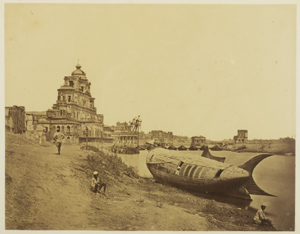
Tilly Kettle (England, 1735-1786) Nawab Shuja al-Daula and his heir apparent, Mirza Amani, future Asaf al-Daula. India, Uttar Pradesh, Faizabad, 1772 oil on canvas 235 x 165 cm Musée national des Châteaux de Versailles et de Trianon, MV 3888, INV 10053, LP 6412 © Musée National des Châteaux de Versailles et de Trianon/ Réunion des Musées Nationaux, Paris/ Art Resource, NY
|
|
MUSÉE GUIMET
6 place d'Iena 75116 PARIS
INFORMATION:
• Tel. 01 56 52 53 00
• Site : www.guimet.fr
OPENING HOURS:
• Open every day, except Tuesday, 10 am to 6pm.
• Ticket counter closes at 5,15 pm , rooms at 5,45.
• Closed décember 25 et january 1. Audioguides free.
ENTRANCE FEES:
• Full price: 8 €
• Concessions: 6 € (- 26 ans)
• Permanent collections: Full price 7,50 €, Concessions 5,50 €, Free under 26
• Combined ticket, exhibition and permanent collections : Full price 9,50 € concessions 7 €
CURATORS:
Jacques Giès, President of the musée Guimet and Amina Taha Hussein-Okada, Curator in chief in charge of the arts of India.
SCENOGRAPHY:
Giada Ricci
PRESS CONTACTS:
• Hélène Lefèvre, Head of Communication
Tel. 01 56 52 53 32
Fax 01 56 52 53 54
helene.lefevre@guimet.fr
• Sophie Maire, assistant
Tel. 01 56 52 54 11
Fax 01 56 52 53 54
sophie.maire@guimet.fr

|
The location is the city of Lucknow, the capital of Awadh, a province of the Mughal Empire in the North of India. It was there that an extraordinarily mixed, diversified and sophisticated society, both Indian and European, came to be and expanded throughout the XVIIIth and XIXth centuries. The musée Guimet presents through nearly two hundred works of art, European oil paintings, watercolors, prints, Indian court paintings, textiles, fine costumes, decorative art objects, gold and silver work, glass and jewels, as well as an important collection of photographs, the first exhibition with an international scope dedicated to the art of crossbreeding that developed from there.
The City of the Nawabs
The influence of Lucknow from the middle of the XVIIIth century to the beginning of the British dominion over India in 1858 was such that it outshone Delhi, the capital of the Mughal Empire. As of 1739, artists, poets and courtesans found refuge in the province of Awadh while Delhi wrestled through a period of trouble. Lucknow also attracted artists, travelers and European diplomatic agents, fascinated by the stories that circulated regarding its beauty, its riches and the generosity of its leaders, the Nawabs. This exhibition explores the dynamism of these exchanges, the encounter of their respective tastes and traditions and the cosmopolitan life style of its inhabitants.
 Felice Beato (Greece, 1832-1909) The Bara Chattar Manzil and the boat in the shape of a fish that belonged to the king . India, Uttar Pradesh, Lucknow, 1858 proof on albumin paper
23.4 x 30 cm Howard and Jane Ricketts collection. Photo courtesy of Howard and Jane Ricketts Collection, London
Far from being limited to a simple presentation of the city's unique heritage, the exhibition aims at telling, in a larger context, the history of this region as well as the history and the colonial memory of India as a whole. Following the uprising of 1857- also known as the “Great Mutiny” or India's First War of Independence, the prestige of Lucknow greatly diminished. Its influence lasted some time, nevertheless. While certain later works lack in diversity and seem obsessed with national identities, others recall the past glory of Lucknow. The city plays an ambiguous role today, in India's popular culture, something between nostalgia for a time forever gone, and a source of national pride and culture.
Lucknow reflected in time
As an echo to the exhibition, a series of contemporary photographs is shown until 25 July in the rotunda. Antonio Martinelli has photographed Lucknow from the same points of view as the artists of the past. His artistic project is presented as a testimony of the changes, the deterioration, as well as the renovations, thus creating a bridge between the two artistic visions: those of the ancient images and those of the contemporary photographs.
PUBLICATION:
• Catalogue of the exhibition: Une cour royale en Inde, Lucknow (XVIIIe-XIXe siècle), directed by Stephen Markel and Tushara Bindu Gude, co-edited by the R.M.N. and the Grand Palais/Musée Guimet, paperback with flaps, 24x30,8 cm, 272 pages, 45 €
• Special issue Beaux-Arts Magazine 9 €
To see more illustrations, click on VERSION FRANCAISE at the top
of this page
 India, Uttar Pradesh, Lucknow, 1826 Watercolor on paper. Approx. 30.5 x 609.6 cm Yale Center for British Art, Paul Mellon Collection, L 500 (8vo) © Yale Center for British Art, USA (Rare Books & MSS, L 500)
|





